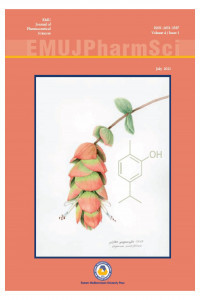The effects of some organic solvents on the modified Ellman procedure for the assay of cholinesterases
The effects of some organic solvents on the modified Ellman procedure for the assay of cholinesterases
___
- Augustinsson KL (1957). Assay methods for cholinesterases. Methods in Biochemical Analysis; Interscience: New York, 5: 1-64.
- Cesarino I, Moraes FC, Lanza MR, Machado SA (2012). Electrochemical detection of carbamate pesticides in fruit and vegetables with a biosensor based on acetylcholinesterase immobilized on a composite of polyaniline-carbon nanotubes. Food Chemistry 135(3):873-879.
- De Jong CF, Derks RJE, Bruyneel B, Niessen W, Irth H (2006). High-performance liquid chromatography- mass spectrometry-based acetylcholinesterase assay for the screening of inhibitors in natural extracts. Journal of Chromatography A. 1112 (1-2): 303-310.
- Dingova D, Leroy J, Check A, Garaj V, Krejci E, Hrabovska A (2014). Optimal detection of cholinesterase activity in biological samples: Modifications to the standard Ellman’s assay. Analytical Biochemistry 462: 67-75.
- Ellman GL, Courtney D, Andres V, Jr., Featherstone RM (1961). A new and rapid colorimetric determination of acetylcholinesterase activity. Biochemical Pharmacology 7: 88-95. Guilbault GG, Kramer DN (1965). Resorufin butyrate and indoxyl acetate as fluorogenic substrates for cholinesterase. Anal. Chem. 37: 120-123.
- Hadd AG, Jacobson SC, Ramsey JM (1999). Microfluidic assays of acetylcholinesterase inhibitors. Anal.Chem. 71 (22): 5206-5212. Koelle GB, Friedenwald JS (1949). A histochemical method for localizing cholinesterase activity. Proceedings of the Society for Experimental Biology and Medicine 70 (4): 617-622.
- Marston A, Kissling J, Hostettmann K (2002). A rapid TLC bioautographic method for the detection of acetylcholinesterase and butyrylcholinesterase inhibitors in plants. Phytochemical Analysis 13 (1): 51-54.
- McOsker DE, Daniel LJ (1959). A colorimetric micro method for the determination of cholinesterase. Arch. Biochem. Biophys. 79: 1-7.
- Miao Y, He N, Zhu JJ (2010). History and new developments of assays for cholinesterase activity and inhibition. Chem. Rev. 110: 5216-5234.
- O’Farrell HK, Chattopadhyay SK, Brown HD (1977). Calorimetry of cholinesterase activity in serum. Clinical Chemistry 23(10): 1853-1856. Walker JP, Asher SA (2005). Acetylcholinesterase-based organophosphate nerve agent sensing photonic crystal. Anal. Chem. 77: 1596-1600.
- Wininteringham FPW, Disney RW (1962). Radiometric assay of acetylcholinesterase. Nature 195: 1303.
- ISSN: 2651-3587
- Başlangıç: 2018
- Yayıncı: Doğu Akdeniz Üniversitesi
Serpil DEMİRCİ KAYIRAN, Neriman ÖZHATAY
Leyla BEBA POJARANİ, Sheida ZARİFİAZAR
Direct SPME/GC-MS analyzes of small citrus fruits cultivated in Turkey
Hale Gamze AĞALAR, Burak TEMİZ, Betül DEMİRCİ, Kemal BAŞER
Morphological and leaf anatomical structure of Pimpinella cypria Boiss.
Sevdenur MUTİ, F. Neriman ÖZHATAY
Myrtle (Myrtus communis L.) and potential health effects
Tugba ERCETİN, Açelya MAVİDENİZ, Karar SHUKUR, Ali KHOSRAVİ, Bahamehr RİAZİ, Fatameh SALAMATİ, Houra SHAHİNFAR, Mohammed NAJJARAN, Muzahem AHMED, Nasim MAHER, Negar KHAJEH, Nezhla DAVDAR, Salva SHAHİNFAR, Hayrettin Ozan GÜLCAN
Investigation of CRISPR anti-phage systems of Lactobacillus plantarum from pickled olives
